
Bog iron is a form of impure iron deposit that develops in bogs or swamps by the chemical or biochemical oxidation of iron carried in solution. In general, bog ores consist primarily of iron oxyhydroxides, commonly goethite.

The Tannehill Ironworks is the central feature of Tannehill Ironworks Historical State Park near the unincorporated town of McCalla in Tuscaloosa County, Alabama. Listed on the National Register of Historic Places as Tannehill Furnace, it was a major supplier of iron for Confederate ordnance. Remains of the old furnaces are located 12 miles (19 km) south of Bessemer off Interstate 59/Interstate 20 near the southern end of the Appalachian Mountains. The 2,063-acre (835 ha) park includes: the John Wesley Hall Grist Mill; the May Plantation Cotton Gin House; and the Iron & Steel Museum of Alabama.
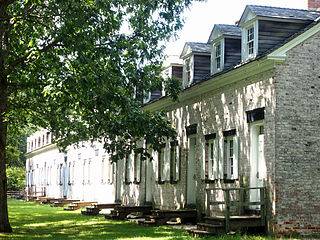
Allaire Village is a living history museum located within New Jersey's Allaire State Park in Wall Township, Monmouth County, New Jersey. The property was initially an Indian ceremonial ground prior to 1650, by 1750 a sawmill had been established on the property by Issac Palmer. The village was later established as a bog iron furnace originally known as Williamsburg Forge 'Monmouth Furnace' was then renamed the Howell Works by Benjamin B. Howell. In 1822, it was then purchased by philanthropist James P. Allaire, who endeavoured to turn into a self-contained community. The wood burning furnace business collapsed in 1846 and the village closed. During its height, the town supported about 500 people. Following his death, the property passed through a number of family members before being used by the Boy Scouts who started to restore the buildings for use as a summer camp. Losing the lease, the property then passed to the State of New Jersey. Allaire Village and its existing buildings are now operated by a non-profit organization - Allaire Village, Inc. Historic interpreters work using period tools and equipment in the blacksmith, tinsmith, and carpentry shops, while the old bakery sells cookies, and general store serves as a museum gift-shop styled store. The church building is frequently used for weddings. The site is also host to community events such as community band concerts, antique sales, weekly flea markets and square dance competitions.
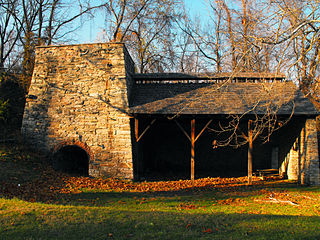
Catoctin Furnace is an historic iron forge located on Route 15 between Frederick and Thurmont in Catoctin Furnace, Maryland. Since it was closed in 1903, no forge has been at the site.

Principio Furnace and village is in Cecil County, Maryland, 4 miles (6.4 km) northeast of Havre de Grace, MD.
The Old Furnace Town Heritage Museum is an outdoor museum near Snow Hill, Maryland that uses a living history format with live demonstrations to re-create a vanished 19th-century community. The museum contains various historic buildings, including most importantly the Nassawango Iron Furnace, an early 19th-century brick blast furnace that was used to smelt bog iron ore to make pig iron. Other buildings, all of which have been moved to the site, include a church, a store, and several houses, one of which is used as an information center.
Nassawango Creek is a stream in the U.S. state of Maryland; it is the largest tributary of the Pocomoke River, located on the Delmarva Peninsula. Older variations on the same name include Nassanongo, Naseongo, Nassiongo, and Nassiungo, meaning "[ground] between [the streams]". Early English records have it as Askimenokonson Creek, after a Native settlement near its headwaters.

Mount Clare, also known as Mount Clare Mansion and generally known today as the Mount Clare Museum House, is the oldest Colonial-era structure in the City of Baltimore, Maryland, U.S.A. The Georgian style of architecture plantation house exhibits a somewhat altered five-part plan. It was built on a Carroll family plantation beginning in 1763 by barrister Charles Carroll the Barrister, (1723–1783), a descendant of the last Gaelic Lords of Éile in Ireland and a distant relative of the much better-known Charles Carroll of Carrollton, (1737–1832), longest living signer of the Declaration of Independence and the richest man in America in his later years, also the layer of the First Stone of the new Baltimore and Ohio Railroad, just a short distance away in 1828.

Gambrill House, also known as Boscobel House and Edgewood, is a house near Frederick, Maryland in the Monocacy National Battlefield. It was listed on the National Register of Historic Places in 1985.

Stafford Hollow, also known as Stafford, Stafford Village, or Furnace Hollow, is a village in the town of Stafford, in Tolland County, Connecticut, located at the junction of Route 19 and Route 319. Stafford Hollow was the town center of Stafford during the 18th and 19th centuries, before the growth of the village of Stafford Springs.

The Elkridge Furnace Complex is a historic iron works located on approximately 16 acres (6.5 ha) at Elkridge, Howard County, Maryland.
Mattapany-Sewall Archeological Site is an archaeological site in St. Mary's County, Maryland. It is located at the Patuxent River Naval Air Station on a level terrace approximately 45' above sea level, less than 1000' south of the Patuxent River in an unused wooded/grassy tract. Documentary evidence identifies the site as Mattapany-Sewall, a manor established in 1663 and occupied from 1666 to 1684 by Charles Calvert, 3rd Baron Baltimore. It served as a governmental meeting place and colonial arsenal, and was the scene of the 1689 battle, known as the Protestant Revolution of 1689, in which Maryland's Proprietary government was overthrown.
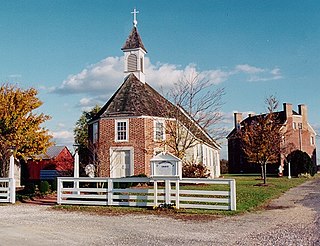
St. Francis Xavier Church and Newtown Manor House Historic District is the first county-designated historic district in Saint Mary's County, the "Mother County" of Maryland and is located in Compton, Maryland, near the county seat of Leonardtown. The district marks a location and site important in the 17th-century ecclesiastical history of Maryland, as an example of a self-contained Jesuit community made self-supporting by the surrounding 700-acre (2.8 km2) farm. The two principal historic structures were added to the National Register of Historic Places in 1972. Archaeological remains associated with the site date back to the early colonial period, mid-17th century.
Fassitt House is a historic home located at Berlin, Worcester County, Maryland, United States. It is a 1+1⁄2-story Flemish bond brick house erected about 1669 on property bordering Sinepuxent Bay. The main side features a carefully laid decorative checkerboard brick pattern. The interior features fine examples of Georgian raised-panel woodwork finish in the first-floor rooms. The property includes two historic outbuildings, a shingled frame smokehouse and a log corncrib, and a modern one-story guest house.
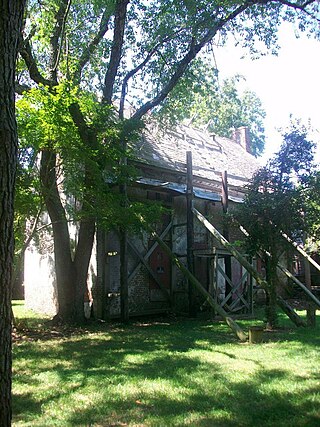
Genesar is a historic home located near Berlin, Worcester County, Maryland, United States. It is a 2+1⁄2-story brick dwelling. It represents the hold-over forms of medieval work and the earliest development towards the more formal Georgian ideals in plan and design.
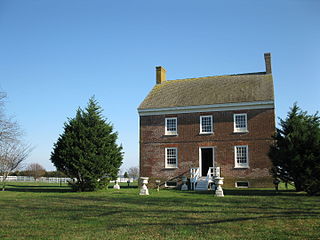
Henry's Grove is a historic home located at Berlin, Worcester County, Maryland, United States. It was built in 1792, and is a 2+1⁄2-story gable-roofed brick house with all walls laid in Flemish bond. The house retains virtually all of its original interior detailing. Also on the property are a 20th-century frame tenant house and four frame outbuildings. It was built for a planter, John Fassitt, whose initials and the date 1792 are inscribed on a plaque in a gable end.
Buckingham Archeological Site is an archaeological site near Berlin in Worcester County, Maryland. It is one of the few known Woodland period village sites in the coastal marsh areas of the Atlantic Coast section of Maryland. The site falls within the general vicinity of an Assateague Indian town. It is located four miles east of the Sandy Point Site, both including the southernmost reported occurrence of Townsend Series ceramics on the coastal section of the Eastern Shore.
Antietam is an unincorporated community and census-designated place in Washington County, Maryland, United States. Its population was 89 as of the 2010 census. It is the site of Antietam Iron Furnace Site and Antietam Village, added to the National Register of Historic Places in 1975.
The Antietam Furnace Complex Archeological Site is an archeological site at Hagerstown, Washington County, Maryland. It is an eighteenth-century Iron furnace located along South Mountain. It operated circa 1768-1775 and produced pig iron, stoves, domestic iron wares, and possibly cannon. It was probably the earliest iron furnace in the present day Washington County.
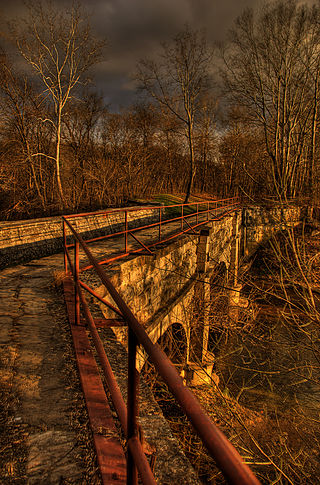
Antietam Iron Furnace Site and Antietam Village is a national historic district at Antietam, Washington County, Maryland, United States. It consists of the remains of a mid-18th to late-19th century iron furnace site, and the nearby related village. Remnants of the ironworks include a dam and race, a possible wheel pit or building foundation, the possible location of a furnace stack, and a four-arch stone bridge built by John Weaver in 1832. Also at the site are the dozen or so brick, stone, and wood houses comprising Antietam Village. Typical of the houses is the Mentzer house, a four-bay, two-storey stone structure of roughly coursed fieldstone, painted white.

















